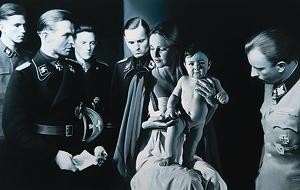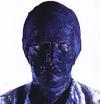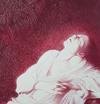Texts and Essays
Rheinisches Landesmuseum Bonn – November 30, 1995
Rheinisches Landesmuseum Bonn, 1996
MADONNA
Gottfried Helnwein's artistic and intellectual approach is to aim quite subtly at producing a crucial feeling of insecurity and a concomitant change of consciousness in the viewer, by using seemingly familiar or usual images that have a certain amount of tradition and an apparently well known composition.

This method is used to jolting effect in the great "Epiphany" (Adoration of the wise men) 1996. In this work, SS officers surround a mother and child group. To judge by their looks and gestures, they appear to be interested in details such as head, face, back and genitals. The mother and the child group finds its direct models in sculptures like Michelangelo's "Maria with the Child", 1503-05, St. Mary's Church in the town of Brugge, Belgium. The arrangement of the figures clearly relates to motive and iconography of the adoration of the three Magi, such as were common especially in the German, Italian and Dutch 15th century artworks. This type of picture, also used in the "Altar of the City Patriarchs of Cologne" by Stefan Lochner about 1440-45 (Cathedral of Cologne), is related to the "Sacra Conversazione", which was especially popular in Italy. In this latter type of work, saints stand in pious conversation around the throne of the Mother of God. Helnwein has merged both types of picture - the animated and contemplative - and has given the scene, with its half figures, a sense of closeness to the viewer and participation by the viewer. By this combining knowledge of a holy subject, the revelation of God to mankind, with the memory of Nazis, Helnwein creates an unholy alliance and both involves and dismays the viewer. The work also alludes to the humanity of God on the one hand and the of the racist superhuman (Übermensch) ideology of the Nazis on the other. In spite of its analogy, in form to the medieval subject of painting, it differs widely from the archetype in its distance and strictness, and in the gracefulness and gestures of the mother and child group, oriented towards the female ideal of the Third Reich; the purpose is the intended effect. The heterogeneity of the scene and the ambivalence of its interpretability lend to the painting something extremely depressing. In the close-up under an arch of the Cologne Hohenzollern Bridge, which seems like a canopy, and in the neighbourhood of Cologne Cathedral in which the relics of the holy three Magi have been buried since 1167, the seemingly harmless scene has a frightening effect and provoked reflection.


